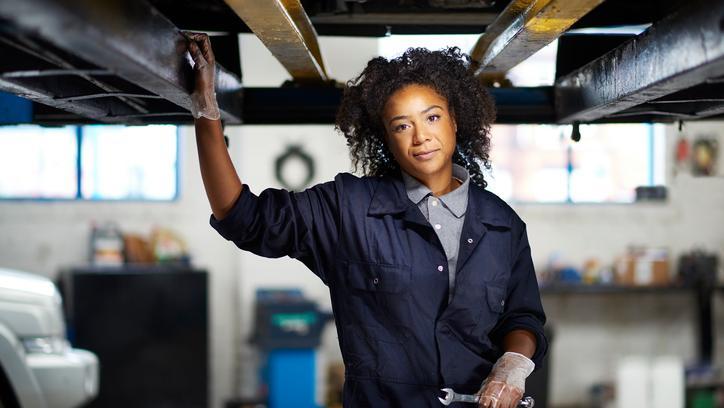Fighting the STEM gender gap with stories of trailblazing female scientists
pri.org - For writer and illustrator Rachel Ignotofsky, the idea to profile 50 pioneering female scientists in her recent book, “Women in Science,” was spurred by conversations with educator friends. As they talked about the gender gap in science, technology, engineering and math fields, Ignotofsky realized women aren’t just underrepresented in STEM, itself — the stories about their contributions don't get much play, either. This story is based on a radio interview. Listen to the full interview.
“I just kept saying over and over again, we ... only talk about female scientists during women's history month,” she says. “We're not taught about them in school. We're not taught about them in history class, and the only one that we do talk about is Marie Curie.”
“So, what happens to young girls and boys when you're not introduced to these strong female role models, who all throughout history have made an immense impact on the sciences?”
The answer to that question is evident by the numbers: There’s a 22 percent gender gap among science and engineering grads, and a 52 percent gender gap among the entire STEM workforce, according to 2011 data from the United States Census Bureau. “I think when people close their eyes and think of who a scientist is, they don't see a woman,” Ignotofsky says.
From Nigeria to Kenya, TechInPink bridges digital divide - Vanguard News
vanguardngr.com - AT face value, Yetunde Sanni and Gertrude Nyenyeshi have nothing in common. Sanni is from Nigeria, Nyeyenshi from Kenya. They haven’t even met in person. At a deeper level however, their love for technology unites them. Both ladies founded, and now run TechInPink, an organisation that teaches women and girls coding and software development regardless of their background. According to Sanni, who is also a full time stack developer at Andela: “We started with blogging which involves teaching other people the craft of software development, we decided to do this because we found out we have very few tech based blogs that are run by women and we took the challenge upon ourselves to transform the false that women can’t write great code tutorials.”
Although the organisation is barely a year old, success stories abound from the ‘pink techies’ efforts. There are two students that readily come to mind when we’re asked about our success stories,” said Nyenyeshi, a full stack Javascript developer.
“One is Salma, an Architecture student in Kenya, and the other is Ruth a paramedical student in Nigeria who we mentored last year. They both had no prior experience but their transformation has been tremendous. We’d also list the two events that we held in both locations a success story as the ladies were introduced and taught about programming and it makes us smile to see some of them actively pursuing opportunities to learn more.”
Women in STEM and the legacy of Ada Lovelace
businessreviewcanada.ca - Women in STEM and the legacy of Ada Lovelace STEM – science, technology, engineering, and mathematics – has long been a male-dominated sector. Historically, men and women have been steered to focus on different career paths, leaving a gap for female scientists and engineers – which, finally, is set to be increasingly filled.
More and more, programs tailor made for women aiming to enter the industry are being created, and multinational software corporation Autodesk has been vocal about supporting this. This year, on Ada Lovelace Day (which falls on the second Tuesday in October), Autodesk released a dedication to Lovelace which also highlighted the work it is doing to support women in STEM.
Ada Lovelace was an English analyst and metaphysician who is hailed as the founder of scientific computing. She was born in 1815, the product of a brief marriage between Romantic poet Lord Byron and Anna Isabelle Milbanke. Lady Byron raised Lovelace to be tutored in mathematics and science as a stark contrast to the creative leanings of her father (despite him having no influence over Lovelace, as she never knew him). In 1828, at just 13 years old, Lovelace created a design for a flying machine.
Between Astronaut Jeanette Epps and Hidden Figures, Black Women in STEM Are in the Spotlight
slate.com - In 2018, astronaut Jeanette Epps will become the first black American astronaut to join the crew of the International Space Station. NASA announced the upcoming months-long mission last week; it will also be Epps’ first trip to space. In a NASA video, Epps said she was inspired to become an aerospace engineer as an elementary schooler by Sally Ride and other early female astronauts, as well as some words of encouragement from her brother. Ladies and gentlemen, female role models in action. Since that fateful early-1980s burst of motivation, Epps worked to build up the kind of unimpeachable résumé it takes to make it to NASA: After getting undergrad and master’s degrees, she earned a Ph.D. in aerospace engineering at the University of Maryland. She then spent a few years working for Ford and the CIA, and again with a little encouragement (this time from a friend and fellow astronaut), Epps landed in NASA’s astronaut class of 2009, one of just nine picks out of 3,500 applicants. (By the way, God, does astronaut school need to be a Shondaland show ASAP.)
Tech's Gender Wage Gap Is Real, Partly Because Men Don't Believe It Is.
Melissa Loble, VP of platform and partnerships at Instructure, talks about the gap -- both in the industry and in perceptions -- and discusses how we might combat it, as well as some encouraging news for the future.
entrepreneur.com - Much has been said and written about the gender gap in tech, including the disparity in pay between men and women. We’ve all seen the statistics. According to salary data from Glassdoor and the U.S. Census Bureau, women in tech fields earn roughly 75–80 percent of that earned by their male counterparts in tech positions. The biggest disparities occur among coders (more on that later). This isn't just a moral problem. It's an issue of missed opportunity for the tech economy. It's time we get beyond acknowledging the problem and get started on figuring out why it exists so we can fix it.
The first step in fixing the wage gap is acknowledging the perception gap. According to a study by Bridge, the corporate training arm of my company, men don’t see the equal pay problem as much as women do. In fact, the majority of men think women have equal opportunity, but less than half of women agree. This finding seems to support the opinion of Andrew Chamberlain, chief economist at Glassdoor. "My view is that in heavily male dominated fields, the people who are making the decisions about pay and promotion are disproportionately men, and that can play a role in why we're seeing gaps in male and female pay," Chamberlain told the L.A. Times.
The Incredible NASA Astrophysicist Teaching Kids All About Science
Amy Mainzer; an astrophysicist at NASA’s Jet Propulsion Lab and the host of "Ready Jet Go!," a new 3-D animated series on PBS; is a great example of what girls--or any kids--can accomplish when they dream and aim big. And she's aiming to help kids reach their goals and explore the universe. Mainzer discusses her own childhood fascination with space, kids' curiosity and how it can drive the next generation of scientists, and the importance of kids having up-to-date and engaging information about the ongoing journey of science.
Her focus on exploration, engagement, and changing perceptions is inspirational. Learn more at the link!
forbes.com - NASA’s Dr. Amy Mainzer is on a new mission – but it’s not into space, yet.
Having developed a young curiosity for space science into a phenomenal career in the field – including as the principal investigator on a major project to study asteroids – Dr. Mainzer has a new goal of educating children in the field and creating the scientists of the future.
As the host and science consultant of PBS’ new TV series, Ready Jet Go!, Dr. Mainzer tells me she is determined to help nurture the natural curiosity of kids around science, technology and space.
“A lot of science and engineering professionals made the decision to work in these fields when they were younger than ten – meaning that small children are making big life decisions,” she explains.
“By making a science show for very young kids, I hope we can foster a love for learning about the universe that stays with them as they hit middle school.”
The series is currently airing on PBS Kids and is aimed at children aged three to eight, with games and further resources online. Marvelously, it follows three kids, one of whose family includes aliens from another planet. They all decide to explore the solar system together, and find out about space science along the way.
Women Hackathons: A Gateway to the Evolution of a More Equal World
The Meera Kaul Foundation addresses gender bias and funds organizations led by women to help “eradicate inequality through education, programs, seminars and conferences.” Check out their post excerpted below and on Entrepreneur Middle East, about hackathons for women: a coding and computer science movement that's sweeping the world to foster cutting edge ideas and collaboration and help women innovators, developers, tech geeks and entrepreneurs form connections and pursue goals that can change the world.
entrepreneur.com - In a world where the rate of female computer science graduates is declining at an alarming rate, the number of women enrolling in technical courses at universities has also seen a dramatic decline—which further impacts the motivation of women already involved in STEM vocations. The end result is a microscopic pipeline of women in STEM careers, primarily computing and engineering. While opportunities in these vocations have evolved, women’s involvement in these domains has plummeted. This is not a pretty equation, both from the perspective of the social and economic status of women, and also from the standpoint of the progress and development of communities, as women are known to be active contributors to the capacity building of other women and their communities.
When I promote hackathons for women, I invariably get asked why such an inclusive program should exist. Our nonprofit organization, the Meera Kaul Foundation, has a program called Women in STEM, whose primary mission is to enable women to educate and build skills to enable careers in highly paid jobs of STEM. Holding hackathons all around the world has been an initiative that we have undertaken the world over, and thus proliferate our mission into regions that need our support the most.
Read more about the Meera Kaul Foundation, Women in STEM, hackathons, and the culture of bias and stereotype women in tech still face here. The second annual Women in STEM Hackathon in Dubai will be held February 19 through 20, welcoming women from across the MENA region.














